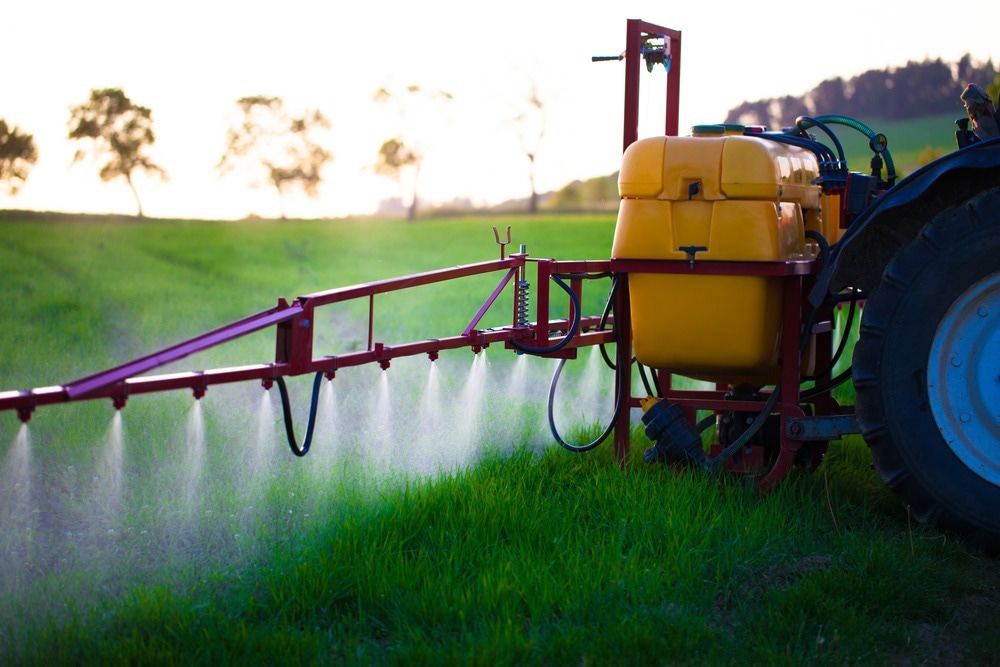In a study published in Chemosensors, researchers developed a luminescent chemosensor to identify and measure the concentrations of organophosphate pesticides in various water samples. The sensor is flexible enough to be easily modified to accommodate the ever-expanding list of new pesticides.

Study: A New Chemosensor Based on a Luminescent Complex for the Investigation of Some Organophosphorus Pesticides in Environmental Samples. Image Credit: PolakPhoto/Shutterstock.com
Organophosphorus Pesticides
Organophosphorus pesticides are frequently used in agriculture to protect plants from weeds, insects, and fungi. It has also been demonstrated that they improve agricultural quality and productivity.
Numerous positive benefits have resulted from the increased adoption of organophosphorus pesticides in agriculture, including higher agricultural yields and lands. Therefore, these pesticides are efficient and economical chemical agents for increasing agricultural yield.
Despite being widely used, pesticides are extremely dangerous to people and cause serious health problems. The yearly usage of 3 million tons of pesticides has led to contamination of drinking water, residue on agricultural goods, and contamination of animal and marine environments.
These challenges are pertinent in agricultural nations with large and well-established agricultural sectors.
Current Organophosphorus Pesticides Detection Methods and Their Limitations
Significant effort is being expended to develop an effective method for detecting organophosphorus pesticide traces. Numerous procedures have been reported for determining organophosphorus pesticides, such as chromatographic, electrochemical, chemiluminescence, and colorimetric methods.
These methods are distinguished by their high selectivity and sensitivity. However, they often need a concentration step to boost detection sensitivity, damaging the sample. The procedures are complex and need expensive equipment and highly skilled technicians.
Luminescence Chemosensors
A fast, sensitive, and simple analytical technique is required to test organophosphorus pesticides regularly.
Luminescent complex chemosensors are the most effective option among various detection methods due to their direct detection capability, high selectivity and sensitivity, and quick response times.
Working principle
The lanthanide ions complexes with organic molecule structures have exceptional photophysical properties that qualify them as light-converting molecular devices. When an organic ligand binds to europium ions, the ligand's excitation energy is transferred to the lanthanide ions, increasing the fluorescence intensity of the europium ions.
Europium (a lanthanide) complexes have powerful emission, bright luminescence and extended lifespan. These unique properties have enabled the development of highly sensitive luminous europium sensors.
Using Luminescence Chemosensor for Detecting Chlorfenvinphos and Malathion Pesticides
A novel chemosensor based on the europium complex with vitamin B1 (vitB1) as a ligand was created for the luminescence-based detection of various organophosphorus pesticides in different water samples.
The detection technique relies on the Eu(III)-vitamin B1 probe's luminescence quenching upon altering the concentration of chlorfenvinphos or malathion.
The sensor's selectivity for chlorfenvinphos and malathion was evaluated using ratiometric analysis. All experiments employed an Eu (III):vitB1 stoichiometry of 1:2.
The measurements were performed thrice, and the average luminescence intensity was determined. Finally, the accuracy of the proposed method was determined by calculating the malathion and chlorfenvinphos recovery percentage in three types of water samples (river water, wastewater, and tap water).
Important Findings of the Study
The chemosensor demonstrated static luminescence quenching with increasing chlorfenvinphos or malathion concentrations. The detection limit for malathion and chlorfenvinphos, respectively, was 0.12 and 0.31 M, which enabled the identification of pesticides at sub-micromolar quantities.
The europium(III)–(vitB1)2 complex is an effective chemosensor for detecting organophosphorus pesticides, as it has determined malathion and chlorfenvinphos in three distinct water samples via a static quenching mechanism.
The sensor's luminescence intensity was reduced via malathion and chlorfenvinphos by 26- and 24-fold, respectively, at 616 nm. The addition of additional organophosphorus pesticides to the europium (III)-(vitB1)2 complex did not elicit any discernible reactions. These results demonstrate the enhanced sensitivity and selectivity of the europium (III)-(vitB1)2 sensor for malathion and chlorfenvinphos in methanol. For malathion, the chemosensor identified the limit of detections that were 2- to 46-fold lower than those for chlorfenvinphos. This is beneficial for the detection of trace quantities of analytes.
Malathion has a 13-fold greater binding affinity than chlorfenvinphos for the Eu(III)-(vitB1)2 complex. The interaction of the sensor with the organophosphorus pesticides under observation was instant and had a negative ΔG0. The proposed luminescent chemosensor is efficient for determining organophosphorus pesticides.
The enthalpy change was negative, and the entropy change was positive as the reaction between the probe and malathion or chlorfenvinphos was exothermic.
Further research will be conducted to create molecularly imprinted polymer (MIP) fiber-optic sensors to monitor organophosphate samples directly.
Reference
Alhamami, M.A.M., Algethami, J.S., Rizk, M.A., Abbas, A.M., & Khairy, G.M. (2022) A New Chemosensor Based on a Luminescent Complex for the Investigation of Some Organophosphorus Pesticides in Environmental Samples. Chemosensors. https://www.mdpi.com/2227-9040/10/10/391/htm
Disclaimer: The views expressed here are those of the author expressed in their private capacity and do not necessarily represent the views of AZoM.com Limited T/A AZoNetwork the owner and operator of this website. This disclaimer forms part of the Terms and conditions of use of this website.